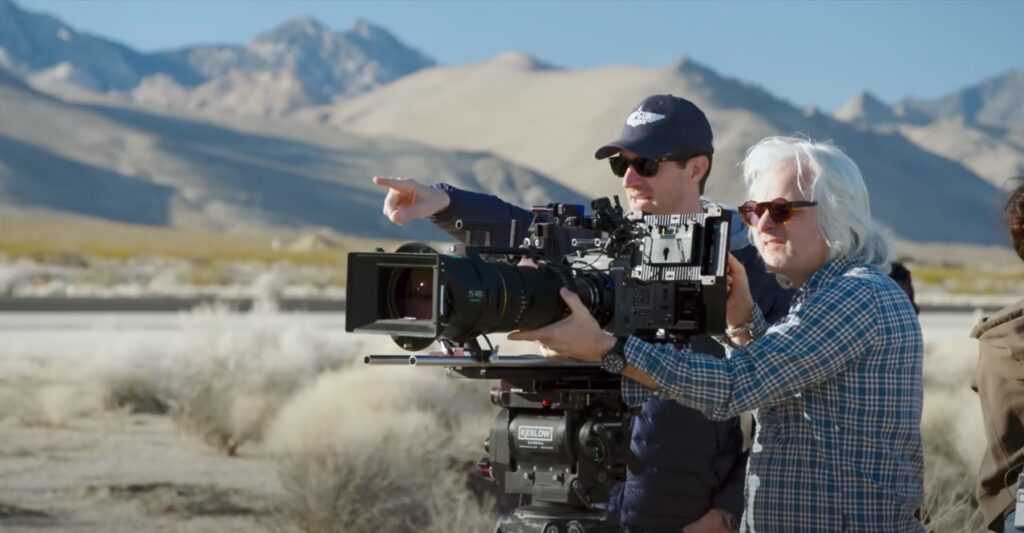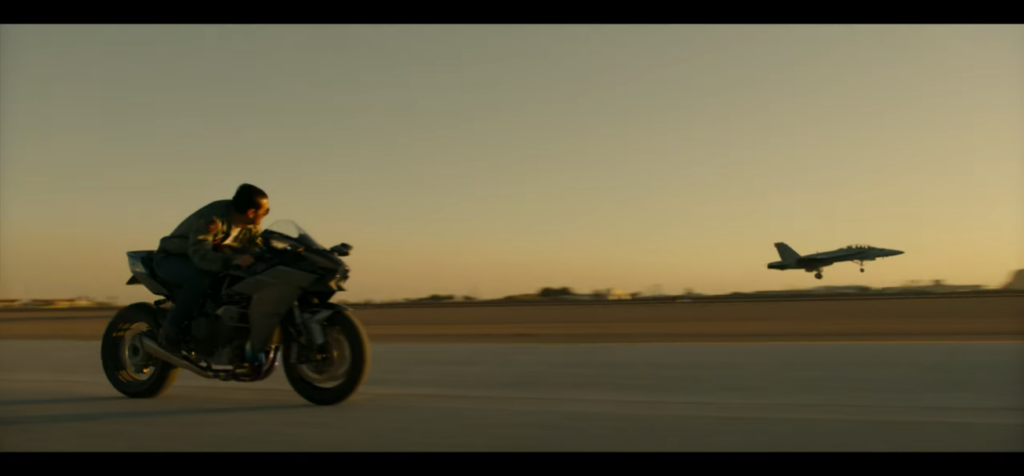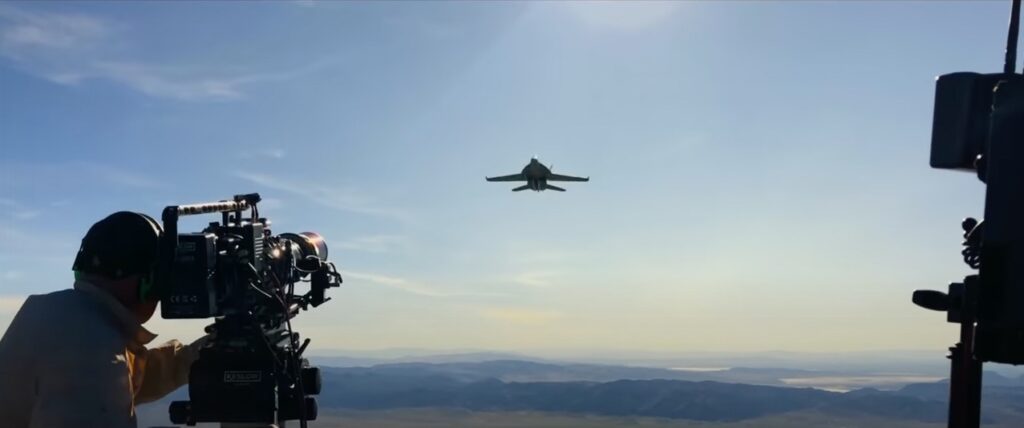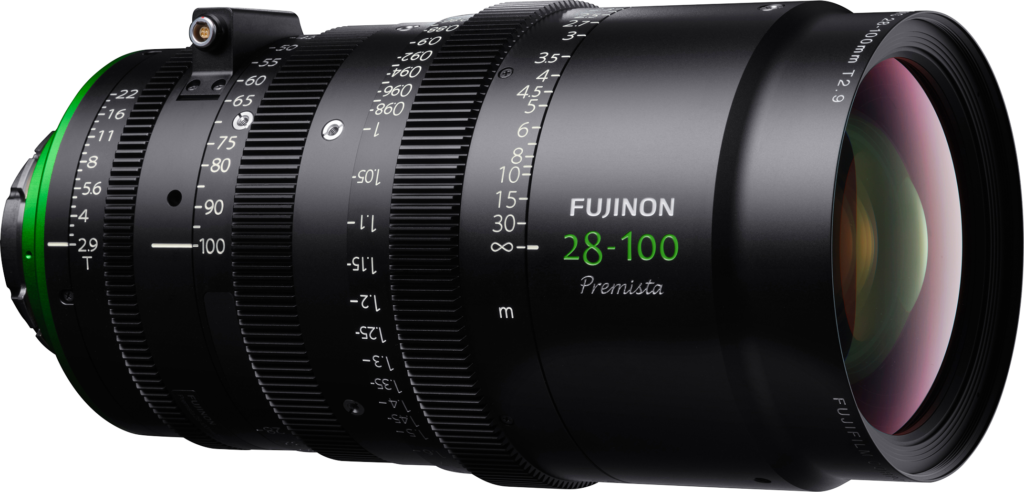Combining cutting edge technologies and FUJINON optics helped cinematographer Claudio Miranda, ASC to deliver breathtaking footage on Top Gun: Maverick

A whole 26 years after the release of the iconic Top Gun, summer blockbuster Top Gun: Maverick redefined the bar for aerial camera work yet again. Its groundbreaking cinematography was handled by a trailblazing aerial team of cinematographers and flight specialists working on new air-to-air and ground-to-air solutions. The team, led by Academy Award-winning cinematographer Claudio Miranda, ASC, invented what was required to obtain practical, in-camera setups that had never been accomplished before.
The key to the team’s success was combining tried-and-tested, top-of-the-line cameras and optics with cutting-edge aerial gimbal technology that allowed the team to creatively push their gear to the limit. In the process, the cinematographers cleared the way for an innovative approach to aerial work and demonstrated what was capable with equipment such as the Sony Venice, Shotover gimbals, and FUJINON Cabrio, Premier and Premista lenses.

When testing camera and lens pairings for the aerial cinematography in Top Gun: Maverick, it was imperative for Claudio to find creative solutions that allowed for the imagery to be created on set, not in post-production. Claudio says: “Top Gun is a movie about getting it in-camera. There is ground-to-air [camerawork], there is air-to-air. Some of the cameras were rigged in impossible places. All these just need a different kind of lens quality. I went through a list of what could fit, but still have great range and clarity, and be IMAX-worthy.”
What I love about the Fujinon zooms – all of them – there’s no oddball distortion when zooming. There’s no vignetting, there’s no softening towards the edges, it’s all straight.
It was a simple decision to rely on Fujinon lenses paired with the Sony Venice. For Claudio, who has enjoyed a long relationship with Fujinon zooms on many of his films, the versatility and robustness of the lenses was exactly what he was looking for. “For Top Gun, a majority of all the exterior lenses were Fujinon. All the ground-to-air, the air-to-air. We needed all those lengths to shoot the F-18s and the versatility they gave us.”
Claudio admires the high performance and dependability of the lenses. “What I love about the Fujinon zooms – all of them – there’s no oddball distortion when zooming. There’s no vignetting, there’s no softening towards the edges, it’s all straight. We just like how it maintains its field of view throughout the zoom range. If you get a flare in the zoom, it doesn’t fog the lens. It’s a beautiful zoom, the coatings are great. The lens doesn’t change its character. When you get to 14.5mm, you expect there’d be barrel distortion, but it’s pretty clean. There’s nothing on that thing.”
Claudio was able to test the new FUJINON Premista 28-100mmT2.9 during production. “We had a chance to get hold of the Premista 28-100mm. It was amazing. I wish we could have kept it, but unfortunately there was only one in the world at the time. We loved the full-frame aspect. It was sharp, it was straight, you went to the long end of the lens and there was no bowing, no barreling. It is one of the only full-frame zooms I know that is decent enough to shoot with.”
At the time of filming, there was only one prototype Premista lens in the US. It was sent to Claudio Miranda, ASC on the Top Gun: Maverick set the day after it came off its launch film, Rhinestone Blue. Only having the lens on the production for a short time, this is the one shot it was used on that made it into the film.
The ability of the Fujinon lenses to perform excellently in intense shooting conditions allowed the aerial crew to place them on specially modified F-18s that could pull 3Gs and fly at 400 miles per hour. David B. Nowell, ASC, who served as an aerial cinematographer for Top Gun as well as Top Gun: Maverick, comments on the performance of the Fujinon lenses: “Regarding reliability or serviceability, I’d have to say reliability is fantastic. Serviceability, I don’t know anything about, because there’s never been a problem. I don’t ever have to send one in.”

David gave Fujinon insight into the technical prerequisites for the film’s aerial aspects, in order to match footage Claudio was shooting on the ground.
“Claudio’s requirement was that we had to use the Sony Venice, but the full-size Venice – it had to have the recording system on the back. That lessened the amount of room we had in here for any particular lens. We needed that 4K coverage, so the best lenses to put on the jets ended up being the FUJINON XK20-120mmT3.5 and ZK85-300mmT2.9-40. That gave us the ability to shoot wide angle, or with the other one on the tail of the plane, we could push all the way into the 300mm.”
Award-winning director and cinematographer Tom Piozet spoke with Claudio and the aerial cinematography team for Fujinon’s documentaries on the making of the film. Tom was impressed with the exceptional quality of the lenses and how seamlessly they cut with other footage. “What I take away the most when I see this film in IMAX, as a cinematographer and filmmaker myself, is how well the combination of Super 35 imagery and Fujinon lenses on the Sony Venice held up against full-frame optics on the Venice. When you see the film in IMAX, they hold up perfectly.”
He was awed by the quality of the lens build. “What is important is that the lenses could withstand extreme temperature changes within the gimbal. In addition to the G forces and possible vibrations in a jet wash, the temperature was changing drastically with the altitude. The back focus was able to hold. That is a real testament to the engineering of both the camera and lenses.”
Tom points out that the back focusing abilities of the lens are beneficial to filmmakers at all levels of production, not only those working on a film such as Top Gun: Maverick. “Owner-operators that aren’t from the cinema world have the ability to do long-term back focus on these lenses – that is super important on any zoom lens. My confidence in Fujinon’s back focus lasting would be vital to an owner-operator.”
With the demanding shooting schedule and numerous practical stunts performed for the film, there was no time for equipment to fail. As an added challenge, whatever was used had to be able to keep up with the fast-flying, G-force-pulling stunts that were the backbone of the film. Kevin LaRosa II, aerial coordinator and lead camera pilot for Top Gun: Maverick, innovated a way to place a Shotover F1 six-axis camera gimbal on the front of an L-39 fighter trainer jet. The rig, known as the L-39 Cinejet, became a staple of the aerial work on Top Gun: Maverick.
All the hundreds of hours I flew on that movie, I don’t ever remember being grounded for a lens or camera issue. It was 100% dispatch reliability, and that’s huge for me as a camera pilot, knowing that the equipment sitting in that gimbal is going to do its job.
Kevin spoke with Fujinon about his rigorous work on the film. “We can fly a Shotover F1 Rush [gimbal rig] on the nose and the tail [of a jet]. We’re flying two Fujinon lenses at the exact same time, with two aerial DOPs on board, and were coming away with two different shots.” Fujinon lenses were the perfect combination of quality, compact size, and robust design to allow for the L-39 Cinejet to keep up with the stunt planes – and even allow for multicam setups.
Ingenuity is beholden to reliability, where Kevin is concerned. To push to the edges of what is possible to film, the equipment cannot fail. The collaboration of an entire creative team went into the making of Top Gun: Maverick, and they were able to achieve never-before-seen footage because of the trust they could place in the equipment.
He attests: “All the hundreds of hours I flew on that movie, I don’t ever remember being grounded for a lens or camera issue. It was 100% dispatch reliability, and that’s huge for me as a camera pilot, knowing that the equipment sitting in that gimbal is going to do its job. If we have a lens malfunction, everything stops. We’re going to land, but we might not be in a position to land. We might have subject aircraft – as in F-18s – up there. So the whole show has to stop and we have to get on the ground and fix it. We don’t have that problem with Fujinon lenses – and that’s why we own them.”
FEATURED PRODUCT

Premista28-100mmT2.9
Premista cinema zoom lenses support large-format sensors and deliver outstanding image quality in high resolution.

